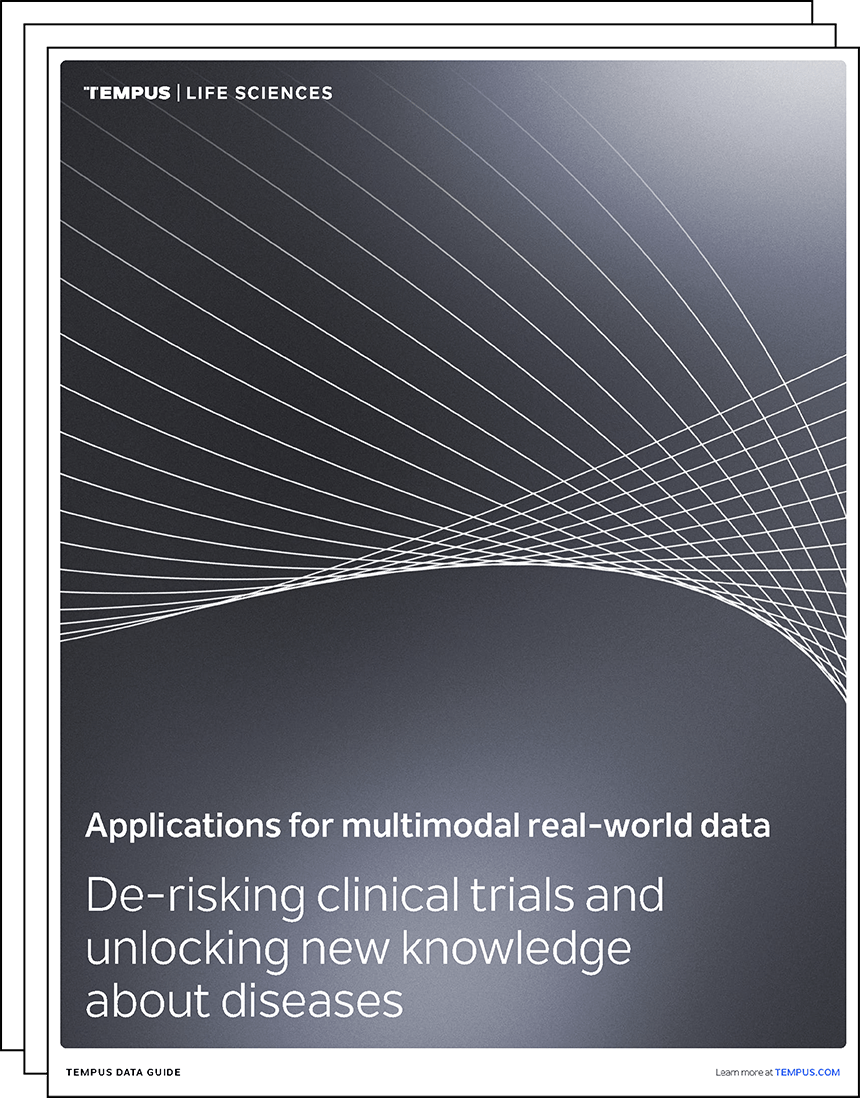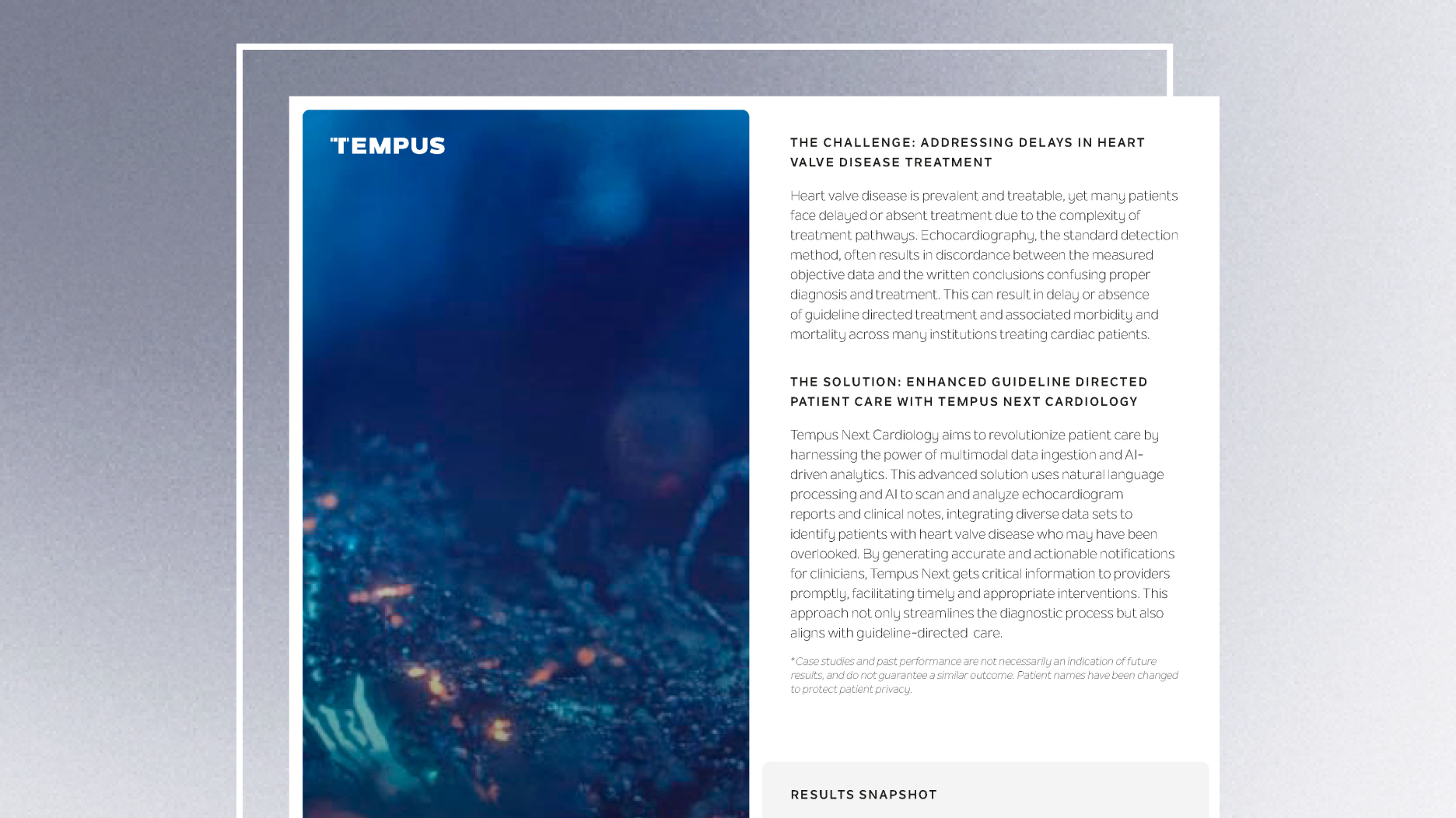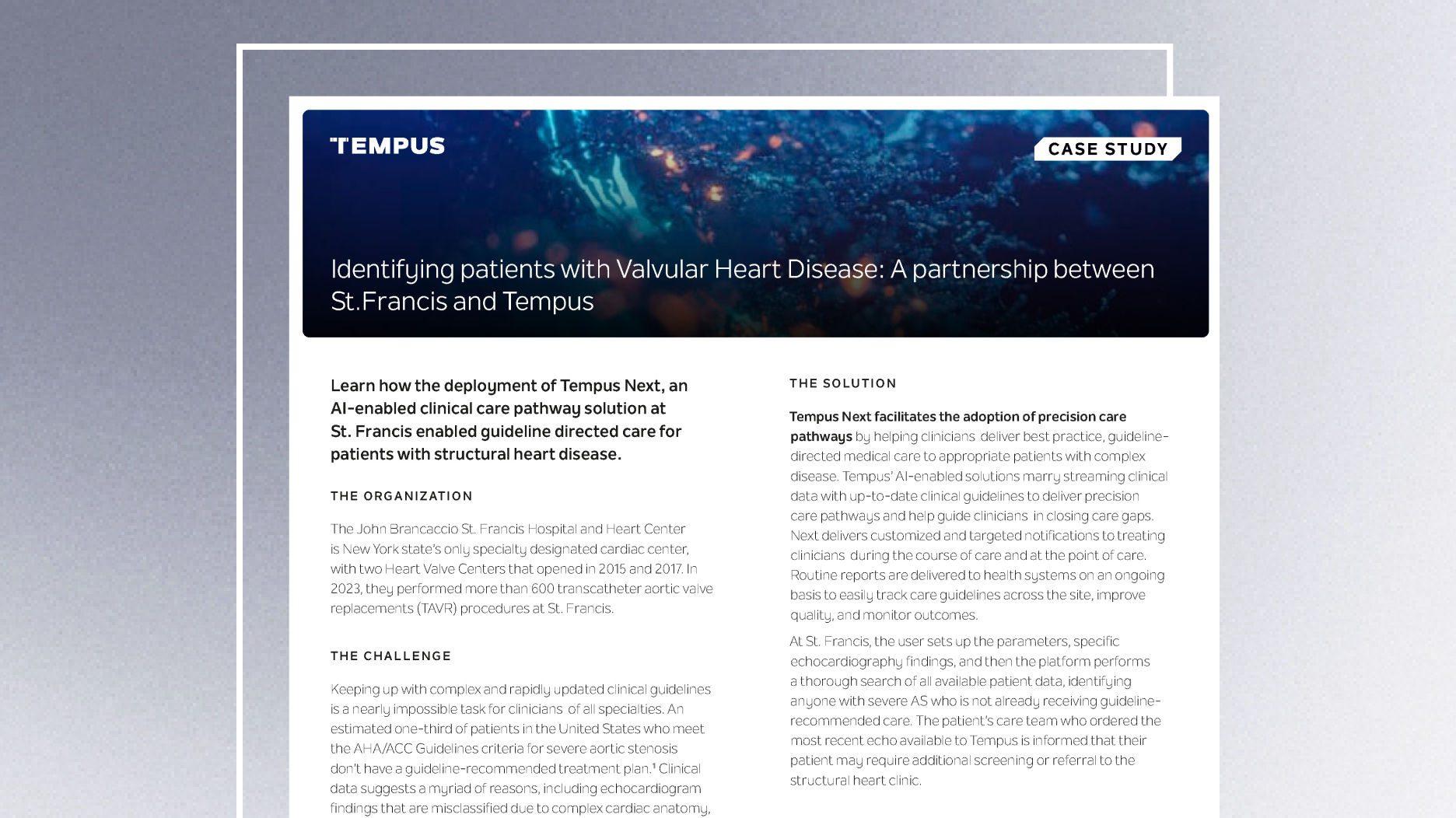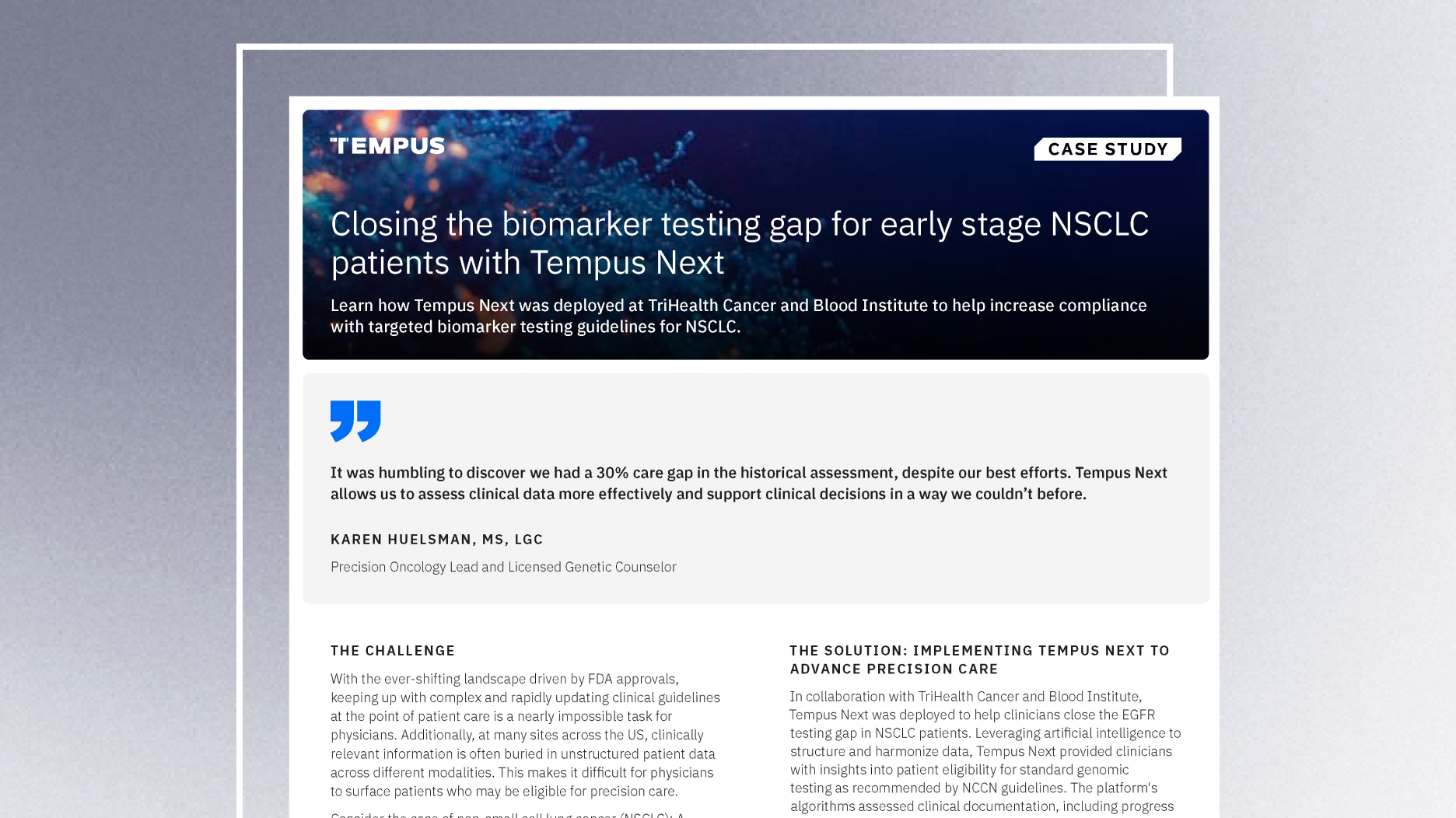-
PROVIDERS
REGISTER NOW
Navigating new frontiers in breast cancer care pathway intelligence: The role of providers and AI
Tuesday, July 29th
2:00pm PT, 4:00pm CT, 5:00pm ET -
LIFE SCIENCES
REGISTER NOW
Closing Care Gaps with AI: The Next Competitive Edge in Pharma
Monday, July 14
9am PT, 11am CT, 12pm ET -
PATIENTS
It's About Time
View the Tempus vision.
- RESOURCES
-
ABOUT US
View Job Postings
We’re looking for people who can change the world.
- INVESTORS
02/16/2023
Use multimodal RWD to drive breast cancer insights
Discover how researchers use Tempus’s multimodal RWD to unlock new knowledge that can inform breast cancer care and drug development.
Authors
Joshua SK Bell
Sr Director of Enterprise Strategy, Tempus

Sr Director of Enterprise Strategy, Tempus

Real-world data (RWD) has emerged as a valuable tool for unlocking new insights about breast cancer biology and treatments, with the potential to provide more accurate, rapid care for patients. However, not all RWD sources are equally useful. Multimodal clinical datasets that include matched DNA and RNA sequencing data provide a unique window into breast cancer and have the potential to facilitate breakthroughs in treatment.
Challenges in breast cancer research
There is a significant amount of publicly available genomic data on breast cancer, but most pertains to early stage disease or lacks current clinical context. By contrast, the development of novel therapies has often focused on late-stage tumors that have worse outcomes. Tumors evolve significantly during progression, with metastasis, and as a result of therapy, emphasizing the need for molecular profiling datasets that are matched with clinical data for representative patient populations. Tempus’s previously published analysis of over 4,000 breast cancer patients highlights the value of RWD in a late-stage population, but as our dataset continues to grow and new drugs are approved, further research is increasingly able to unlock new discoveries.
Given the rapidly changing therapeutic landscape, whereby new treatments are coming to market and standard-of-care is evolving, older RWD can reflect outdated practices. As a result, when researchers use historical RWD to build external control arms or to help de-risk clinical trials by testing hypotheses before recruiting patients, they may use data that misrepresents the current clinical reality. This can lead to misrepresentations in the resulting evidence, which may cause a trial to ultimately fail.
For example, in two abstracts Tempus prepared for the 2022 San Antonio Breast Cancer Symposium (SABCS) – Shah et al and Chica-Parrado et al (see below) – we specifically analyzed mutational profiles generated from tumors following failure on CDK4/6 inhibitors (assayed by both solid and liquid biopsy). For these types of analyses, using recent data is critical since patterns of usage of CDK4/6 inhibitors have evolved significantly since these drugs were first approved in 2015. We observed significant molecular changes following CDK4/6i treatment, which demonstrates the value of increasingly common, less invasive liquid biopsy tests such as circulating tumor DNA (ctDNA) tests.
The opportunity for multimodal RWD to improve evidence generation
Multimodal data can be a powerful tool to support research into patients’ real-world experiences with the latest standards of care. RNA and DNA sequencing data – including the ability to quantify tumor mutational burden (TMB) and information on the tumor microenvironment – as well as lab test results and clinical information from electronic health records and other sources, are all critical pieces to the multimodal data puzzle.
RNA sequencing data provides the most granular view of a tumor’s transcriptional activity, while providing enhanced fusion detection, thereby enabling more potentially clinically actionable information over DNA alone. It also helps identify the presence of immune cells, including which immune-related pathways are being used by a patient’s tumor – information that researchers can use to identify new biomarkers and drug targets.
Tempus findings on HER2-low patient populations
HER2-targeting therapies have been around for decades, but they have traditionally been used to target tumors with high levels of HER2 protein. Until recently, there were no positive clinical trials performed for HER2-targeting agents in people with lower levels of HER2 protein expression.
Last year, one groundbreaking trial revealed that HER2-low patients respond to trastuzumab deruxtecan, a HER2 targeted therapy, a finding that opened doors for new treatment opportunities in this patient population. Today, we have a unique opportunity to power research into treatments for HER2-low patients. Using Tempus’s RNA data, we can review detailed molecular information on HER2-low or HER2-negative patients to identify new populations of patients to target in clinical trials.
At the 2022 SABCS, Tempus researchers presented findings on the use of multimodal RWD in breast cancer – including HER2-low and triple-negative patients – using Tempus’s multimodal and RNA datasets.
In one study, “Molecular characterization of HER-2 low patients identifies basal-enriched subset with poor clinical outcomes in RWD,” we characterized the HER2-low population and compared outcomes across molecular subtypes. We retrospectively characterized HER2-low patients in our database to document that they are a heterogeneous population consisting of each classical (HR+, TNBC) or transcriptional (PAM50) subtypes, rather than representing a distinct molecular subtype of breast cancer.
Another study assessed HER2 mutations, which occur when there are changes to the DNA of cancer cells. This study, “Gene expression and mutation profiles in HER2-mutated metastatic breast cancer,” sought to understand the molecular characterization of HER2-mutant breast cancers (representing two to five percent of metastatic breast cancer patients) compared to those of HER2-amplified and HER2-wild type patients. We found that HER2-mutant tumors display elevated HER2 expression, as well as frequent co-mutation with the CDH1 gene. These findings may aid in developing novel targets and combination therapy strategies.
Two other posters explored treating HR+ breast cancer patients with CDK4/6 inhibitors – including palbociclib, ribociclib, and abemaciclib, which are often given along with antiestrogens. To advance drug development, it is important to understand the genomic landscape of people whose cancers have progressed while on CDK4/6 inhibitors since these individuals are often the subject of clinical trials for novel therapies.
One of these studies – “Genomic landscape of Er+/HER2-metastatic breast cancer as a function of prior treatment with a CDK4/6 inhibitor” – explored differences in TMB between metastatic HR+/HER2- patients following treatment with CDK4/6 inhibitors (alongside antiestrogens) and those not yet treated with these therapies. The research showed significant differences in the mutational landscapes between these patient populations, including expected ESR1 resistance mutations in both solid and liquid biopsy samples following treatment with CDK4/6 inhibitors.
We took these findings further in a related study “The mutational landscape of 1172 patients with hormone receptor-positive, HER2-negative metastatic breast cancer treated with CDK4/6 inhibitors.” Here, we assessed genomic differences between metastatic HR+/HER2- breast cancer tumors after receiving at least 6 months of palbociclib vs ribociclib vs abemaciclib. Our researchers found potential differences in the mutational findings and TMB values among patients treated with different CDK 4/6 inhibitor therapies, though additional research is required to confirm these findings of altered molecular profiles.
Exploring new avenues for breast cancer treatment
By leveraging Tempus’s database, these studies represent an important step toward a better understanding of breast cancer populations. With access to our rich data source, we at Tempus are characterizing the molecular and clinical profiles of patients in need of novel therapeutics, who have often failed on the standard of care, and leveraging insights from this data to inform trial design and advance cancer treatment.
There are many critical questions to explore as we continue to improve treatment and diagnosis for patients with metastatic breast cancer. With deep, timely data that reflects the latest clinical advancements and standard of care, Tempus’s data enables new opportunities to address today’s queries and improve tomorrow’s care.
Learn more

Learn more
Applications for multimodal real-world data
De-risking clinical trials and unlocking new knowledge about diseases
DOWNLOAD GUIDEStay informed
Be notified whenever Tempus publishes new and relevant research, webinars, and other resources.
Sign up-
06/25/2024
Revolutionizing Cardiac Care: AI-driven detection and treatment of critical heart valve disease at Boulder Community Health
Discover how Tempus Next's AI-powered care pathway platform transformed patient outcomes by helping ensure timely, guideline-directed treatment for critical heart valve disease at Boulder Community Health
Read more -
04/15/2024
Identifying patients with Valvular Heart Disease: A partnership between St.Francis and Tempus
Learn how the deployment of Tempus Next, an AI-enabled clinical care pathway solution at St. Francis enabled guideline directed care for patients with structural heart disease.
Read more -
04/15/2024
Closing the biomarker testing gap for early stage NSCLC patients with Tempus Next
Learn how Tempus Next was deployed at TriHealth Cancer and Blood Institute in Cincinnati, Ohio to surface and close gaps in biomarker testing for NSCLC patients.
Read more


